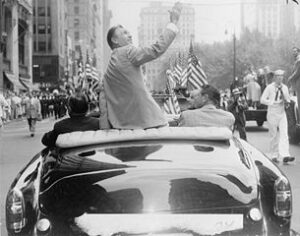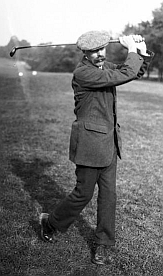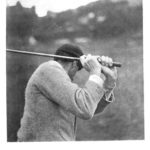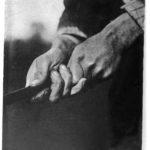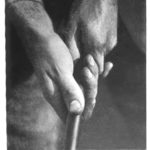An Iron Man of Golf
Ben Hogan, was born on August 13, 1912, in Dublin, Texas and he is regarded as one of the greatest golfers of all time. Ben Hogan had exceptional skill, strong determination, and he made an amazing comeback to the top of golf after a car accident nearly killed him.
His Struggling Years and Professional Success
Ben Hogan turned professional in 1929 and spent years paying his dues and sharpening his golf skills. Hogan dug his game out of the dirt with hard work. He worked as a club pro and competed in tournaments. Hogan’s breakthrough came in 1940 when he won the Vardon Trophy for the lowest scoring average on the PGA Tour.
A 1940s Golf Force
The 1940s were a magical time for Hogan. He became a dominant force on the PGA Tour. Hogan captured many titles, including the U.S. Open in 1948, the PGA Championship in 1946 and 1948, and the Vardon Trophy three times. Ben Hogan’s precise ball-striking, strategic genius, and great concentration made him a formidable golfer.
His Near-Fatal Automobile Accident and a Miraculous Comeback
In 1949, Hogan’s life nearly ended in a severe car accident when a bus crossed the center line of a foggy road and hit his Cadillac head-on. At the last moment before impact, Ben dove to the right to shield his wife Valerie who was sitting in the front passenger seat. The move probably saved his life too as the steering wheel was thrust into the driver’s seat, it would have killed him outright. Valerie had only minor injuries. Hogan suffered life-threatening injuries and doctors questioned if he would ever walk again. Playing golf at its highest level once more seemed to be an impossibility for Hogan. The doctors shortchanged Ben Hogan’s indomitable spirit and ability to work relentlessly toward a goal. Ben Hogan wanted to return to golf. After months of grueling rehabilitation to regain his strength and stamina, Hogan returned to professional golf in 1950.
Hogan’s 1953 Triple Crown
Hogan’s comeback to professional golf’s top after the automobile accident was nothing short of miraculous. In 1953, he won three major championships including the Masters, U.S. Open, and the British Open. This was called the Triple Crown. Ben Hogan, nicknamed “The Hawk,” had become one of golf’s all-time greats. Ben Hogan set a standard in golf and his legacy remains. Ben Hogan passed away on July 25, 1997.
Here are 65 Quotes by and about Ben Hogan:
#1. “When I play with him, he talks to me on every green. He turns to me and says, ‘You’re away.'” – Jimmy Demaret,
#2. “Golf is not a game of good shots. It’s a game of bad shots.” – Ben Hogan
#3. “I always outworked everybody. Work never bothered me like it bothers some people.” – Ben Hogan
#4. “There isn’t enough daylight in any one day to practice all the shots you need to.” – Ben Hogan
#5. “Every day that I missed practicing takes me one day longer to be good.” – Ben Hogan
#6. “Reverse every natural instinct and do the opposite of what you are inclined to do, and you will probably come very close to having a perfect golf swing.” – Ben Hogan
#7. “I hate a hook. It nauseates me. I could vomit when I see one. It’s like a rattlesnake in your pocket.” – Ben Hogan
#8. “You never fight your eye when you look at a hole. If it looks one way, play it that way. Don’t make a big deal out of an easy shot.” – Ben Hogan
#9. “For myself and other serious golfers, there is an undeniable beauty in the way a fine player sets his hands on the club.” – Ben Hogan
#10. “I play with friends, but we don’t play friendly games.” – Ben Hogan
#11. “Relax? How can anybody relax and play golf? You have to grip the club don’t you?” – Ben Hogan
#12. “There are no shortcuts in the quest for perfection.” – Ben Hogan
#13. “People have always been telling me what I can’t do. I guess I have wanted to show them. That’s been one of my driving forces all my life.” – Ben Hogan, after winning the 1951 U.S. Open at Oakland Hills. It was the longest U.S. Open course up to that time.
#14. “I’m glad that I brought this course, this monster, to its knees.” – Ben Hogan, after winning the 1951 U.S. Open at Oakland Hills.
#15. “Thank you. How did you do?” – Ben Hogan after being congratulated for winning the 1951 U.S. Open by runner-up Clayton Heafner.
#16. “Why don’t you aim more to the right?” – Ben Hogan, after being asked by a golfer about why so many of the golfer’s shots go left.
#17. “You only hit a straight ball by accident. The ball is going to move right or left every time you hit it, so you had better make it go one way or the other.” – Ben Hogan
#18. “I have never achieved what I thought was success. Golf to me is a business, a livelihood in doing the thing that I like to do. I don’t like the glamour. I just like the game.” – Ben Hogan
#19. “This is a game of misses. The guy who misses the best is going to win.” – Ben Hogan
#20. “Placing the ball in the right position for the next shot is 80-percent of winning golf.” – Ben Hogan
#21. “You have to give careful thought to every shot. Every shot sets up what you are going to do next. Every shot has to be placed correctly. Don’t ever just hit a shot without thinking it through.” – Ben Hogan
#22. “I dreamed I made 17 holes-in-one, and on the 18th hole I lipped the cup and I was madder than hell.” – Ben Hogan
#23. “A good round of golf is if you can hit about three shots that turnout exactly as you planned them.” – Ben Hogan
#24. “The ultimate judge of your swing is the flight of the ball.” – Ben Hogan
#25. “The most important shot in golf is the next one.” – Ben Hogan
#26. “For what Hogan meant, it’s the old story: For those who know golf, no explanation is necessary. For those who don’t, no explanation is possible.” – Sportswriter Jim Murray
#27. “He was the greatest player I ever played with. If he could putt 25 percent as well as Palmer could, he would have won 50 more tournaments. Don’t forget that he made all the putts he had to make to win his nine majors.” – Tommy Bolt
#28. “Hogan plays one game and the rest of us play another.” – Dave Marr
#29. “He was a cold, detached artisan on the course, likened by some observers to an undertaker weaving a shroud of defeat for his adversaries.” – Writer Will Grimsley
#30. “He looks at you like a landlord asking for next month’s rent.” – Anonymous
#31. “The three things I fear most in golf are lightning, Ben Hogan and a downhill putt.” – Sam Snead
#32. “As you walk down the fairway of life you must smell the roses, for you only get to play one round.” – Ben Hogan
#33. “The most important shot in golf is the next one.” – Ben Hogan
#34. “Every day that you don’t practice is one day longer before you achieve greatness.” – Ben Hogan
#35. “This is a game of misses. The guy who misses the best is going to win.” – Ben Hogan
#36. “The greatest pleasure is obtained by improving.” – Ben Hogan
#37. “If you can’t outplay them, outwork them.” – Ben Hogan
#38. “Your name is the most important thing you own. Don’t ever do anything to disgrace or cheapen it.” – Ben Hogan
#39. “Golf is 20 percent talent and 80 percent management.” – Ben Hogan
#40. “There are no shortcuts in the quest for perfection.” – Ben Hogan
#41. “May thy ball lie in green pastures, and not in still waters.” – Ben Hogan
#42. “The only thing a golfer needs is more daylight.” – Ben Hogan
#43. “Hitting a golf ball and putting have nothing in common. They’re two different games. You work all your life to perfect a repeating swing that will get you to the greens, and then you have to try to do something that is totally unrelated. There shouldn’t be any cups, just flag sticks. And then the man who hit the most fairways and greens and got closest to the pins would be the tournament winner.” – Ben Hogan
#44. “I liked to win, but more than anything, I loved to play the way I wanted to play” – Ben Hogan
#45. “I never played a round when I didn’t learn something new about the game.” – Ben Hogan
#46. “I have really enjoyed every minute I have spent in golf- above all, the many wonderful friends I have made. I have loved playing the game and practicing it. Whether my schedule for the following day called for a tournament round or merely a trip to the practice tee, the prospect that there was going to be golf in it made me feel privileged and extremely happy, and I couldn’t wait for the sun to come up the next morning so that I could get out on the course again.” – Ben Hogan
#46. “A shot that goes in the cup is pure luck, but a shot to within two feet of the flag is skill.” – Ben Hogan
#47. “The average golfer’s problem is not so much the lack of ability as it is lack of knowledge about what he should be doing.” – Ben Hogan
#48. “The ultimate judge of your swing is the flight of the ball.” – Ben Hogan
#49. “When you see an opportunity, you practice and work, at least from sunup to sundown.” – Ben Hogan
#50. “Control is the main thing, and the tee shot is the most important shot in golf. You’ve got to hit the fairway before you have a good chance of putting the ball close to the pin. You can be the greatest iron player in the world, but if you’re in the boondocks it won’t do you any good.” – Ben Hogan
#51. “All other things being equal, greens break to the west.” – Ben Hogan
#52. “If a man can shoot 10 birdies, there’s no reason why he can’t shoot 18. Why can’t you birdie every hole on the course?” – Ben Hogan
#53. “There is no similarity between golf and putting; they are two different games, one played in the air, and the other on the ground. – Ben Hogan
#54. “Shoot a lower score than everybody else.” – Ben Hogan
#55. “This is a game of misses. The guy who misses the best is going to win.” – Ben Hogan
#56. “Like most professional golfers, I have a tendency to remember my poor shots a shade more vividly than the good ones.” – Ben Hogan
#57. “Certainly, if you can’t manage your game, you can’t play tournament golf. You continually have to ask yourself what club to play, where to aim it, whether to accept a safe par or to try to go for a birdie. You can’t play every hole the same way. I never could.” – Ben Hogan
#58. “If the Masters offered no money at all, I would be here trying just as hard.” – Ben Hogan
#59. “Hit the ball up to the hole… You meet a better class of people up there.” – Ben Hogan
#60. “Golf was my life. I didn’t want to give it up. So I went to work!” – Ben Hogan
#61. “Selecting a stroke is like selecting a wife. To each his own.” – Ben Hogan
#62. “There’s no set time or schedule for developing one’s skills as a professional golfer, and it certainly doesn’t come overnight. It’s a muscle-memory exercise that comes over time.” – Ben Hogan
#63. “You only hit a straight ball by accident. The ball is going to move right or left every time you hit it, so you had better make it go one way or the other.” – Ben Hogan
#64. “You hear stories about me beating my brains out practising, but the truth is, I was enjoying myself. I couldn’t wait to get up in the morning, so I could hit balls. When I’m hitting the ball where I want, hard and crisply, it’s a joy that very few people experience. When I practiced, I practiced to get it right.”</em> – Ben Hogan
#65.“Good golf begins with a good grip.” – Ben Hogan
My Book:
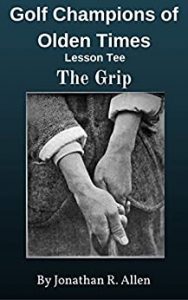
Golf Champions of Olden Times Lesson Tee – The Grip
In my book golf champions of the past instruct you on how to have a good grip on the golf club. Old time champions of golf like Harry Vardon, J. H. Taylor, James Braid, James M. Barnes, and others give you their instruction of having a good and correct golf grip.
* Preview And Have A Look Inside Golf Champions Of Olden Times Lesson Tee – The Grip *
In my book golf champions of the past instruct you on how to have a good grip on the golf club. Old time champions of golf like Harry Vardon, J. H. Taylor, James Braid, James M. Barnes, and others give you their instruction of having a good and correct golf grip.
In Golf Champions Of Olden Times Lesson Tee – The Grip past golf champions who were major tournament winners, PGA Tour winners, and members of the World Golf Hall of Fame will teach you the the Vardon Overlapping Grip and its variations. These golfers of olden times were the best players of golf during their time. Learn how to have a correct and good golf grip from them.
Get Golf Champions Of Olden Times Lesson Tee – The Grip Paperback or Kindle Edition now!
